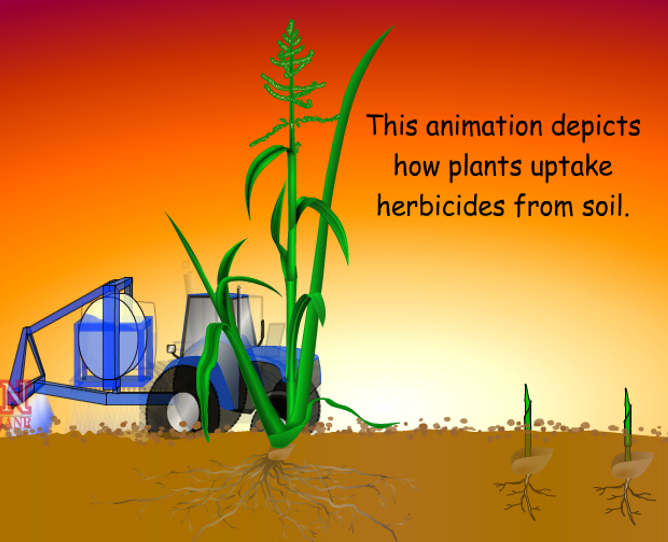Chapter 14: Applied Herbicide Physiology and Movement
14.4 Soil Active Herbicides
Click through this animation to discover key factors to consider when applying herbicides to the soil, in order to maximize the effectiveness of the herbicide. The animation requires flash player to be enabled in your internet browser.

As illustrated in the animation, some soil active herbicides are absorbed by plant roots but not shoots. While other soil active herbicides are absorbed by plant shoots and less by roots. Therefore, correct placement of the herbicide in the soil with respect to the plant’s site of uptake will influence the herbicide’s effect and is an important management consideration.
For herbicide absorption to occur, soil active herbicides must come in contact with the plant. They do this through one of three processes: mass flow, contact, or diffusion.
- With mass flow, herbicide molecules are carried along with soil moisture as the plant absorbs water. An analogy would be a piece of wood floating with the current in a stream (with the wood representing the herbicide and stream representing water in the soil).
- Contact simply implies that plants come in contact with herbicides in the soil by the roots or shoots ‘growing into’ the herbicide.
- The diffusion process is one in which molecules move from an area of high concentration to an area of lower concentration. Diffusion can take place in both a liquid and a gaseous medium although with the exception of fumigants, most soil applied herbicides move very little in the gaseous phase. It is worth noting that the use of fumigants is heavily regulated.
For any of these three mechanisms to function, adequate soil moisture is required. With mass flow water is the ’vehicle’ carrying the herbicide molecule. Moisture is required for the plant to be actively growing and absorbing water. For the plant to ‘grow into’ the herbicide, soil moisture is required to support plant growth. For diffusion to function as a mechanism of contact, soil moisture is required to serve as the phase to dissolve the herbicide. For these reasons, activity of soil-applied herbicides is enhanced by adequate soil moisture conditions and reduced by limited soil moisture.
If you are interested in learning more details of herbicides absorbed by roots then move through plant, there is a nice animation at the Plant and Soil Sciences eLibrary: http://passel.unl.edu/pages/animation.php?a=RootUptake.swf&b=1011734185
Review and Reflection